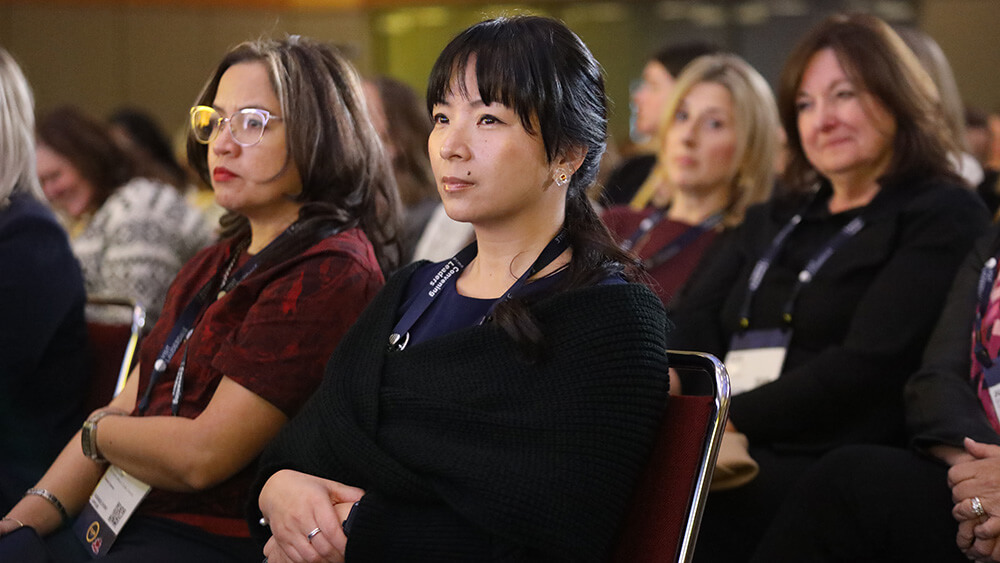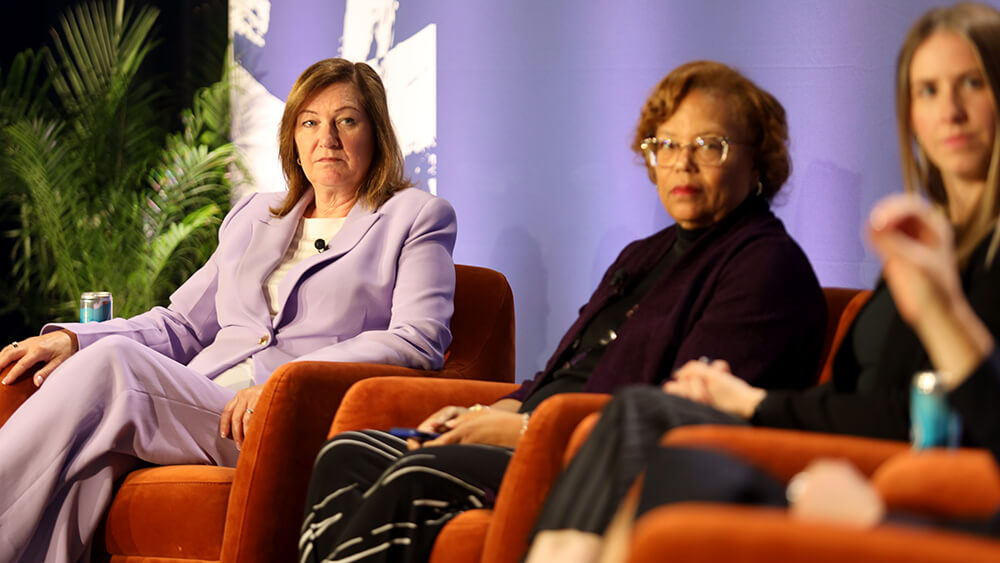
At Convening Leaders 2024, 800 people registered for the session “Unlocking Potential: Strategies for Advancing Women in Business Event Leadership Roles.” (Whatever Media Group)
During a career that includes a dozen years as CEO of Business Events Sydney (BESydney), Lyn Lewis-Smith has encountered countless panels at business events where, she said, “there could have been better gender balance.” In recent years, however, as organizers have become much more conscious of the value of diversity, equity, and inclusion “we are getting great diversity on panels at conferences,” she said. “It’s getting better and better.”
But, as Lewis-Smith discovered when she looked into workplace gender equity statistics in Australia, the same can’t be said for those who occupy the events industry’s uppermost positions. Although the majority of those who work in the events industry in Australia are women, only one in five senior leaders is female. Women leaders are not only underrepresented relative to their employment in the events industry, but they also lag significantly behind the share of senior leadership roles held by women globally, which is 32 percent. The only industries in Australia with fewer female leaders than the events industry, Lewis-Smith said, are construction and mining, two heavily male-dominated industries. “That got me thinking,” she said. “I wanted to question that.”
In partnership with the PCMA Foundation, Lewis-Smith and BESydney launched a research initiative that has done exactly that. The report, “Advancing Women in Business Events,” quantifies the representation of women leaders in the business events industry relative to the global workforce, explores possible reasons why there are so few in the C-suite, and outlines a series of recommended actions that individuals, organizations, and an industry-wide coalition can take. The research project was conducted through a series of global in-person and online think tanks with male and female executives, one-on-one interviews with female business events executives, and a global DEI survey.
“We can’t wait,” Lewis-Smith said at Convening Leaders 2024, where Part I of the report was released. It’s time, she said, for the business events industry to work out the pathways for women to take a seat at the table where decisions are made. “This is our moonshot.”
Convene spoke with Lewis-Smith over Zoom about the report’s findings and the role of mentoring in women’s advancement. Here are some excerpts from that conversation:

Lyn Lewis-Smith (left), CEO of Business Events Sydney, helped spearhead the report, “Advancing Women in Business Events.” (Whatever Media Group)
The report looked at multiple barriers preventing women from rising to top spots in the business events industry, including personal, organizational, and societal roadblocks. Where do you start?
At the panel session that we did at Convening Leaders, “Unlocking Potential: Strategies for Advancing Women in Business Event Leadership Roles,” there were 800 people registered. What that tells me is that women want to see women at the top and to be inspired to pursue the pathway to CEO and the C-suite. One of the things that was glaringly obvious is that we need to get out of our own way.
I think a global mentoring program is where to start because there doesn’t seem to be a lot of mentoring or coach- ing happening at the organizational level — and individuals probably aren’t seeking out people in the C-suite who are females to be mentored by. One of the things that I’ve found valuable is to hold women’s lunches and breakfasts — reach out to people you aspire to, and then to people in your cohort so you feel comfortable. Everyone pays their way, and you have a breakfast or a luncheon, and then you form friendships. And that’s where mentoring and coaching starts.
If you can’t get a seat at the table, then make your own table. A lot of women aren’t invited to the table — some are, but not enough. Let’s start our own, and then reverse the system by introducing real diversity to that table.
In fact, one of the biggest lacks identified in the survey was mentoring and sponsorship opportunities. Less than one-third of respondents said formal networking to this end is offered by their organizations, and only 6 percent said that they have access to formal sponsorship programs.
A mentoring program, done on an industry or organizational level, is low-hanging fruit and an easy place to start. There’s the 20 in Their Twenties programs, but there’s nothing specifically for women in their 20s, 30s, and 40s to be mentored by women in the C-suite. And, if any men wanted to come forward and be part of that — this isn’t an I or a me, it’s we. We need more male champions of this.
And I don’t think organizations are doing enough at the professional development level. Women said in the report that their organizations weren’t investing in them. That’s something that I ensured as I came in as CEO of BESydney, that every single person in the organization had a professional development plan. And we allocate significant budget to developing our people. As I said on stage [at Convening Leaders], you are not serious about developing your people if you don’t have a line item in your budget. And I would say to organizations that if you want to retain your talent, then you need to look at pathways for professional and personal development.
The report also recommends that organizations find a way to implement flexible working arrangements to accommodate child or elder care for both men and women. It also references the fact that women typically work longer hours taking care of family.
In Australia — and I think this is a societal issue because the women are seen as the “carers,” something that through the centuries we actually have been — only 14 percent of men are taking up paid parental leave. So until we get to parity around men saying, “It’s okay for me to step outside the workforce and look after my newborn while my partner goes back into the workforce” — until we get there — we are going to be challenged. But it is improving. I think that’s a good sign. And I think in three decades’ time, that will change significantly, because I’m even seeing it in our own organization, where the dads are really taking time off. I think with the [generations] now coming through the ranks, we’re going to see swift change in the next three decades.
Eight Barriers
The report identified eight “consistent challenges” across all global regions in advancing women into leadership roles within the business events industry, including:
- Pay equity
- Flexibility in work hours, as women typically bear the double burden of work and family care
- Lack of opportunities for career progression
- Shortage of diverse talent represented in the industry, particularly on leadership teams
- Lack of support for learning and growth, skill development, and mentoring
- Gender biases inhibiting women from advancing into leadership positions
- Women’s own limiting beliefs about themselves and their ability to compete for or successfully carry out leadership roles
- Different forms of discrimination, including gender discrimination carried out by management, colleagues, and customers/members
Research Highlight
- Nearly 60 percent of respondents felt leadership roles at their organization were not available to them, or if they were, that they did not have clear steps on how to advance into them.
- Fewer than one-third of respondents agreed that diverse identities are represented at the leadership level across the business events industry.
- One-quarter of respondents said that they have either directly experienced or witnessed discrimination in their work environment either from management, colleagues, or customers/members.
From “Advancing Women in Business Events DEI Survey,” conducted by PwC and based on 438 respondents from 30 countries; 96 percent of whom identify as female, 4 percent as male.
On the Web
Find the research report, “Advancing Women in Business Events: Part I at convn.org/advancing-women. Part II of the report will be available in April.
Barbara Palmer is deputy editor of Convene.
